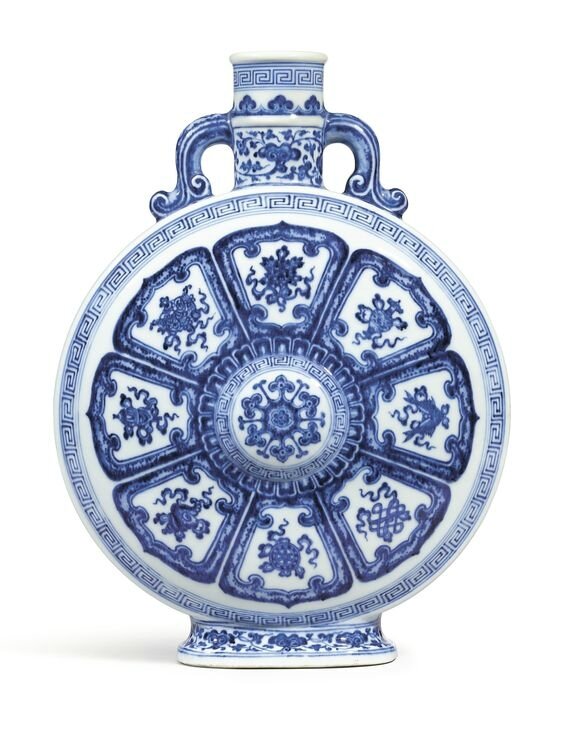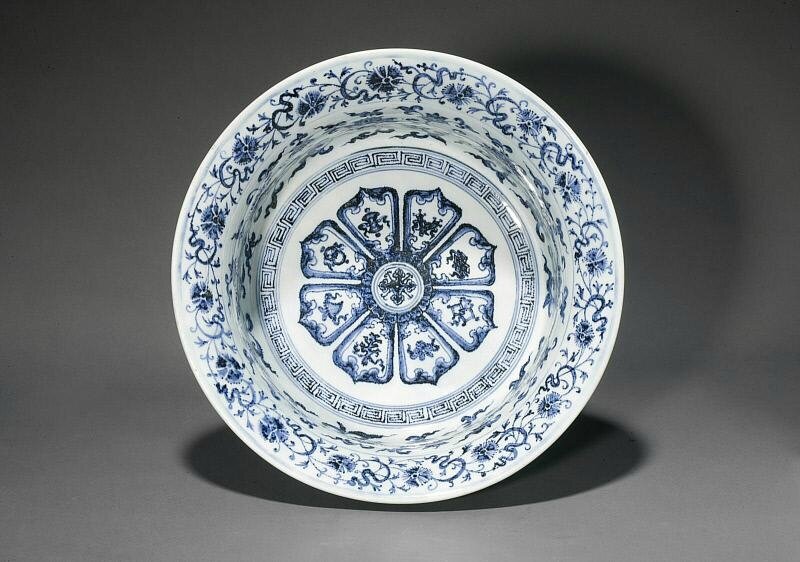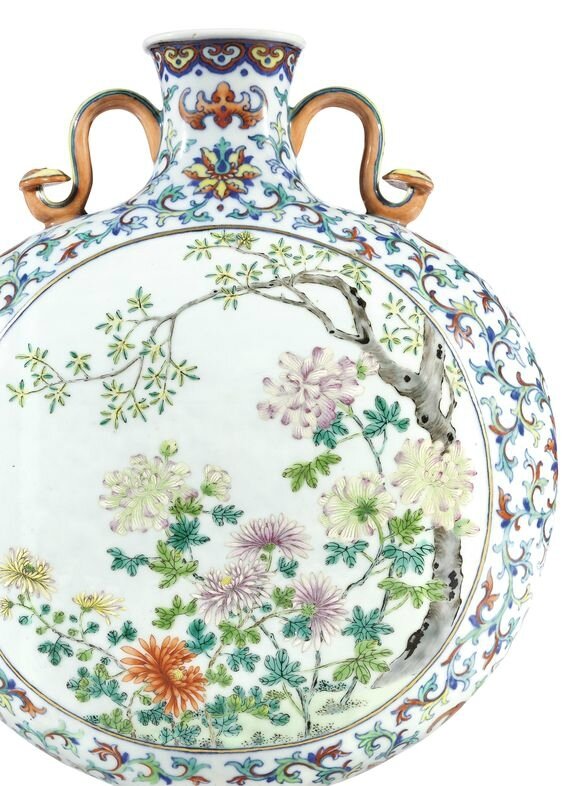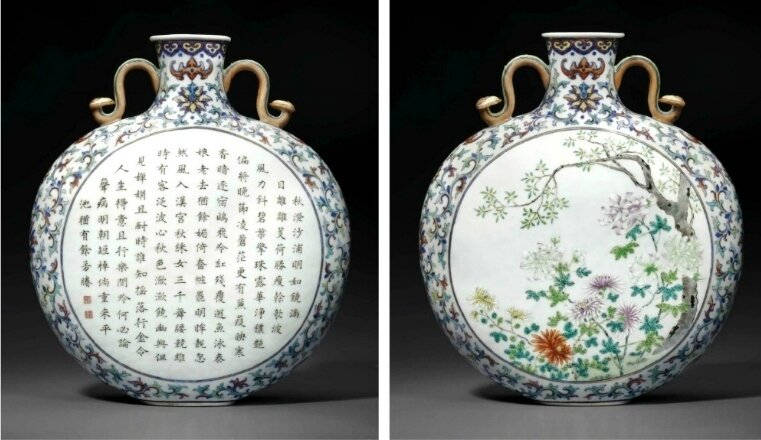Left to right: Oscar de la Renta, Custom Evening Coat, 2012, silk taffeta, the Collection of Annette de la Renta (worn by Annette de la Renta at the Schiaparelli and Prada: Impossible Conversations Costume Institute Gala at the Metropolitan Museum of Art, 2012); Evening Dress, fall 1996, silk crepe with bead and sequin embroidery, the Collection of Annette de la Renta; Evening Cape, fall/winter 1993–94, silk satin, the Collection of Annette de la Renta. © Fine Arts Museums of San Francisco.
HOUSTON, TX.- On October 8, the Museum of Fine Arts, Houston, opens The Glamour and Romance of Oscar de la Renta, an exhibition celebrating the illustrious life and career of the influential fashion designer. Presented in collaboration with Oscar de la Renta, LLC, the exhibition features nearly 70 ensembles sourced from de la Renta’s corporate and personal archives, the archives of French label Pierre Balmain, private lenders, and the collection of the MFAH. On view from October 8, 2017, to January 28, 2018, the exhibition is curated by André Leon Talley, former American editor-at-large for Vogue magazine and lifelong friend of the designer, in collaboration with Cindi Strauss, Sara and Bill Morgan Curator of Decorative Arts, Craft and Design at the MFAH, with assistance by fashion historians Molly Sorkin and Jennifer Park.
From the start of his award-winning career, which spanned more than five decades and two continents, Oscar de la Renta set out to design beautiful clothes for every occasion in a woman’s life. The Glamour and Romance of Oscar de la Renta highlights recurring themes throughout his career, including the significant impact of Spain, Russia, China, Japan, and the garden on his designs. Displayed along with paintings and decorative arts from the collection of the MFAH, the creations on view offer a window into de la Renta’s world through a range of looks, from elegant daywear to resplendent evening gowns.
“The exquisite designs on view demonstrate Oscar de la Renta’s innate talent, and the ability of his creative vision, drawn from rich and complex cultures around the world, to transcend well beyond the world of fashion,” commented Gary Tinterow, director of the Museum of Fine Arts, Houston. “We’re proud to partner with Oscar de la Renta, LLC to present these extraordinary creations this fall.”
“We are honored that the Museum of Fine Arts, Houston, is mounting a full-scale exhibition of Oscar’s work,” said Alex Bolen, CEO of Oscar de la Renta, LLC. “The Museum’s incredible collection, augmented by loans from around the world and open access to our extensive archives, curated by Oscar’s dear friend André Leon Talley, will showcase Oscar’s extraordinary contribution to the world of fashion.”
Exhibition Overview
The ensembles on view are organized into four thematic sections, each enriched by a variety of visual assets, including images of de la Renta’s private gardens in Connecticut. Paintings and decorative arts from the Museum’s collection provide additional context for the artistic and cultural influences prevalent throughout the designs on display.
Spain
The exhibition opens with a look into one of the most significant influences on de la Renta’s oeuvre: Spain, the country where he launched his career. After arriving in Madrid, in 1951, de la Renta was hired by the legendary couturier Cristobal Balenciaga, who was similarly inspired by the spectacle and pageantry of Spanish culture. De la Renta’s experience of Spanish artists, bullfights, flamenco dance, and festive celebrations informed the silhouettes, ornamentation, and palette of his collections, showcased in this section by ensembles featuring elaborate tassels, embroidery, and cascading ruffles.
The East
The next section explores the influence of the geographical region spanning the Middle East to the Far East—including Russia, North Africa, and Turkey—on de la Renta’s designs. Some of de la Renta’s most romantic collections were created with this region in mind, represented here by silk ensembles, caftans, and harem pants, alongside Russian-inspired garments with luxurious furs, ornate textiles, and jeweled appliqué.
Garden
Another of de la Renta’s lifelong passions was the garden, as explored in this next section. De la Renta cultivated an interest in all things horticultural from a young age on the grounds of his childhood home in the Dominican Republic, and later in life, through the formal gardens of his Connecticut residence. Vibrant colors, delicately applied flowers, floral-printed silk taffetas, and full skirts evoking petals in bloom reflect the infusion of botanical themes throughout his work. De la Renta was also inspired by the 18th-century silhouettes, patterns, and colors worn by Queen of France Marie-Antoinette as reflected in the daywear and gowns on display.
Icons
For decades, women around the world have chosen de la Renta’s designs for their most celebrated and cherished occasions, from presidential dinners and award shows to weddings and fundraising galas. The exhibition culminates in a display of de la Renta’s technical mastery of dressmaking, fully demonstrated by ready-to-wear and custom couture creations alike. Viewers can see gowns once worn by dignitaries, celebrities, and philanthropists, including Penelope Cruz, Kirsten Dunst, Karlie Kloss, Laura Bush, and Lynn Wyatt.
![37]()
Oscar de la Renta, Evening Ensemble, 1960-69. © Museum of Fine Arts, Houston.
![38]()
Oscar de la Renta, Evening Ensemble, detail, 1960-69. © Museum of Fine Arts, Houston.
![34]()
Oscar de la Renta, Evening Dress, Fall 1967. ©Museum of Fine Arts, Houston.
![20]()
Left to right: Oscar de la Renta, Coat and Dress Ensemble, fall 1968, novelty weave fabric, fur, and brilliants, the Museum of Fine Arts, Houston, gift of an anonymous lady; Oscar de la Renta, Evening Ensemble, 1960–69, metallic thread, brilliants, plastic beads, sequins, and feathers, the Museum of Fine Arts, Houston, gift of Margaret Alkek Williams. © Museum of Fine Arts, Houston.
![32]()
Oscar de la Renta, Coat and Dress Ensemble, Fall 1968. © Museum of Fine Arts, Houston.
![31]()
Oscar de la Renta, Coat and Dress Ensemble, detail, Fall 1968. © Museum of Fine Arts, Houston.
![28]()
Oscar de la Renta, Evening Ensemble, detail, 1960–69. © Museum of Fine Arts, Houston.
![24]()
Oscar de la Renta for Pierre Balmain, Evening Dress, fall/winter 1998–99, silk taffeta with bead, sequin, and metallic-thread embroidery, and chenille yarn, Texas Fashion Collection, University of North Texas, gift of Mercedes Bass. © Fine Arts Museums of San Francisco.
![23]()
Oscar de la Renta for Pierre Balmain, Evening Dress, fall/winter 1999–2000, silk velvet, silk embroidery, and silk appliqué. © Fine Arts Museums of San Francisco.
![22]()
Oscar de la Renta, Custom Evening Ensemble, 2001, silk taffeta and silk satin, courtesy of Oscar de la Renta Archive (worn by Mica Ertegun to an event celebrating her 40th wedding anniversary to Ahmet Ertegun, 2001). © Fine Arts Museums of San Francisco.
![36]()
Oscar de la Renta, Evening Ensemble with Reproduction Blouse, Resort 2002. © Fine Arts Museums of San Francisco.
![30]()
Oscar de la Renta for Pierre Balmain, Evening Dress, Autumn Winter 2002-2003.
![29]()
Oscar de la Renta for Pierre Balmain, Coat, Autumn Winter 2002-2003. © Museum of Fine Arts Houston
![39]()
Oscar de la Renta, EveningEnsemble, Spring Summer 2004. © Museum of Fine Arts Houston
![35]()
Oscar de la Renta, Evening Dress, Spring 2005. © Museum of Fine Arts Houston
![33]()
Oscar de la Renta, Day Ensemble, Fall 2005. © Museum of Fine Arts Houston
![18]()
Wedding dress of Amal Clooney, 2014. © Museum of Fine Arts Houston
![21]()
Oscar de la Renta for Jane Derby, House Sketch of Day Ensemble, Dress and Jacket of Yellow and White Wool, fall 1966, courtesy of Oscar de la Renta Archive.
![26]()
House Sketch of Evening Dress of Polychrome Lamé, Sable, and Metallic Braid, fall 1968, courtesy of Oscar de la Renta Archive.
![25]()
House Drawing, spring 1992, courtesy of Oscar de la Renta Archive.
![27]()
Photo by Paul Hurschmann.







































































































































































